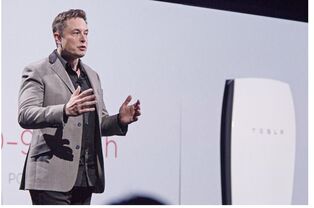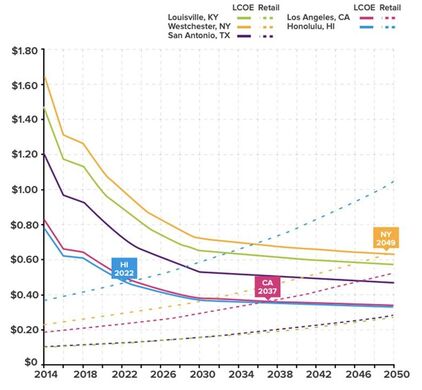Slowly but surely, energy storage is becoming cheaper. This development will fundamentally change consumer relationships with their electricity utilities . There is a growing recognition that storage will subject the utility business model to major disruption. Instead of thinking of electricity as the core product, utilities could increasingly be paid for providing additional high-quality services and charge customers a premium for their connection. Indeed, grid defection - as customers leave their utilities to rely on their own power generation - is a growing phenomenon in some regions, raising alarm bells in corporate offices. In some countries with particularly high prices, the pressure is more urgent. This is evident in Jamaica where the University of the West Indies, the island's largest educational institution, announced it will leave the grid entirely in favor of self-generation of electricity - albeit mostly from gas turbines as opposed to solar plus storage. In the United States and Europe, total grid defection remains uneconomical for most. However, partial grid defection - the installation of solar plus storage while remaining attached to the grid - is on the rise.
Utility Death Spiral
Utility Death Spiral
|
This raises the specter of "Utility Death Spiral", defined by Lane Sharman, the Executive Director of San Diego Energy District, as when "a utility loses customer revenue from self-generation of electricity from solar or wind or some other technology, it stimulates the utility to raise rates for other customers so as to preserve its revenue base." Utility Death Spiral is a scary prospect for the companies concerned. If more consumers defect from the grid, it reduces the demand for electricity. For the company, the fixed costs remain the same inevitably forcing them to raise prices, which in turn encourages more people to leave the grid. The downward spiral ultimately could lead to bankruptcy for a utility with many negative implications for its remaining customers.
Social Justice Against Renewables? |
Tesla's "Powerwall" encourages customers to rely less on utilities -
which is having big impacts on their electricity demand. |
|
If adequate preparation is not made for changing technology, higher prices will have a regressive impact, hurting the poorest in society the most. These are the individuals that cannot afford to leave the grid and invest in solar panels with a battery backup. This argument is often used to halt the proliferation of decentralized renewable energy by companies looking to preserve their interests and the status quo - blocking policies such as net-metering. So the question remains: how do we ensure that the electricity grid - which the majority will continue to use - remains functioning? One option is nationalization, but this could be a drain on government funds and be politically difficult. Another option is innovation and preparation. Utilities should find ways to change their business models and allow for the distributed generation, and encourage people to remain on the grid and charge appropriately. This must be done by encouraging distributed renewables in an economically progressive way.
The Battle Against A Greening Grid |
Projected off-grid vs utility price projections for different US states
|
Utilities largely impacted by domestic solar installations are looking to raise the cost for customers that use solar energy. In Nevada, the Public Utilities Commission approved a bill increase tripling a fixed connection fee for solar systems and cutting the value of credits customers earn by feeding excess electricity back into the grid, threatening the local solar industry. Similar moves are being promoted by utilities worldwide looking to protect their profits. But new technologies may provide another market for electricity. "A greening grid, alongside rapid technological and other changes in transportation, is providing the basis for a counter-narrative to the utility death spiral," states the Brattle Group’s March 2018 report "New Sources of Utility Growth: Electrification Opportunities and Challenges" (PDF). The savior for utilities may be electricity sales growth stemming from increased electrification of the economy in areas such as transportation, heating and cooling.
The Move To Electric Vehicles
The Edison Electric Institute claims that electric vehicles (EVs) could provide the load growth that utility companies so desperately need. The electrification of the transportation sector is a substantial but long-term opportunity for growth in demand. The U.S. Energy Information Administration, states that “the transportation sector is the second largest consumer of energy in the U.S. (behind electric power generation), and yet 93% of the energy consumed in transportation today comes from petroleum. Electrifying the transportation sector is a proactive, positive strategy: it enables significant economic and environmental benefits and new opportunities for consumer engagement.” One significant issue is that peak demand times could be significantly increased by people returning home and charging their EVs. However, with the use of smart vehicle-to-grid (V2G) technology could potentially overcome that risk. V2G allows for electric vehicles to communicate with the power grid to buy and sell electricity to smooth out peak and low demand times. V2G storage capabilities would also allow for EVs to store and discharge electricity generated from intermittent renewable energy sources such as solar and wind - providing a network of additional storage for the grid.
An Integrated Utility Services Model
Maybe all this makes look the age of the utility is behind us, but there are innovations that suggest otherwise such as the integrated utility services (IUS) model. The IUS Model developed by the Rocky Mountain Institute for Fort Collins Utilities (Colorado) places energy efficiency and rooftop solar as default options for residential and small commercial customers, financing other mechanisms to ensure no increase in customers' monthly utility bills, and preserve utility revenue. The IUS could provide an alternative pathway, but it will not be an easy ride. Utility companies would need to seamlessly blend an array of products, services and financing tools that have not previously been integrated. If successful, it could be a model for municipally-owned utilities like Fort Collins and independent utilities alike.
Utilities have a big opportunity if they change their business models, the IUS model and related approaches to leverage their direct access to energy customers and provide them with the very products that are traditionally viewed as a threat. Maybe it is time to take a fresh look at the activities and services these departments know so well. After all, those services could be utilities’ biggest hope for the future.
The Move To Electric Vehicles
The Edison Electric Institute claims that electric vehicles (EVs) could provide the load growth that utility companies so desperately need. The electrification of the transportation sector is a substantial but long-term opportunity for growth in demand. The U.S. Energy Information Administration, states that “the transportation sector is the second largest consumer of energy in the U.S. (behind electric power generation), and yet 93% of the energy consumed in transportation today comes from petroleum. Electrifying the transportation sector is a proactive, positive strategy: it enables significant economic and environmental benefits and new opportunities for consumer engagement.” One significant issue is that peak demand times could be significantly increased by people returning home and charging their EVs. However, with the use of smart vehicle-to-grid (V2G) technology could potentially overcome that risk. V2G allows for electric vehicles to communicate with the power grid to buy and sell electricity to smooth out peak and low demand times. V2G storage capabilities would also allow for EVs to store and discharge electricity generated from intermittent renewable energy sources such as solar and wind - providing a network of additional storage for the grid.
An Integrated Utility Services Model
Maybe all this makes look the age of the utility is behind us, but there are innovations that suggest otherwise such as the integrated utility services (IUS) model. The IUS Model developed by the Rocky Mountain Institute for Fort Collins Utilities (Colorado) places energy efficiency and rooftop solar as default options for residential and small commercial customers, financing other mechanisms to ensure no increase in customers' monthly utility bills, and preserve utility revenue. The IUS could provide an alternative pathway, but it will not be an easy ride. Utility companies would need to seamlessly blend an array of products, services and financing tools that have not previously been integrated. If successful, it could be a model for municipally-owned utilities like Fort Collins and independent utilities alike.
Utilities have a big opportunity if they change their business models, the IUS model and related approaches to leverage their direct access to energy customers and provide them with the very products that are traditionally viewed as a threat. Maybe it is time to take a fresh look at the activities and services these departments know so well. After all, those services could be utilities’ biggest hope for the future.




